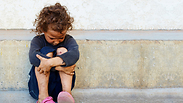
Report reveals rise in number of poor seniors
National Insurance Institute's 2012 stats show number of young families, children living under poverty line decreased from previous year
The number of poor families in Israel slightly decreased in 2012, the National Insurance Institute's report on poverty revealed Tuesday.
The report, however, won't be considered a badge of honor for the country. There was a drop in the number of young families with one to three kids who were living under the poverty line, but there also was an increase in the number of families headed by seniors who were living under the poverty threshold.
Related stories:
- Report: Needy children steal, dumpster dive to eat
- Seniors struggle to pay for heating amid extreme storm
- OECD: Israel poverty high despite strong economy
In 2012, there were 439,500 poor families, a total of 1,754,700 people, and of which 817,200 were children. The authors of the report said that the poverty numbers from 2011 to 2012 were negatively influenced by drastic measurement changes that the Central Bureau of Statistics undertook during those years.
The number of poor families in 2012 fell to 19.4%, along with the number of total poor people, which fell to 23.5% of the total population. The amount of poor children fell to 33.7%, but the rate of poor elderly rose to 22.7%
The percentage of families with two workers or more, which were once considered immune from falling under the poverty threshold, rose to 5% in 2012 from 2% at the beginning of the decade.

The National Insurance Institute said that looking at the numbers long-term and in an international comparison, the poverty rate remained high as in previous years.
The authors of the report explained that the reason for the increase in the number of seniors under the poverty threshold was that in 2009-2011 there was legislation to increase old-age pensions. However, given the growth in the general standard of living, poverty still rose among seniors, as for most their income is based on government allowances and not pensions.
The poverty rate for working families remained the same in 2012, standing at 13.7%. In 1999, only 7% of working families were under the poverty line. Non-working families, who are less than 10% of families in the country, saw an increase in their poverty rate, reaching 66.1% in 2012.
The report also established that the rates for the poverty gap were not uniform in 2012. The gap didn’t change from 2011 to 2012, and the rate for severity of poverty, the gap between the poverty line and the average income of poor people, decreased.










